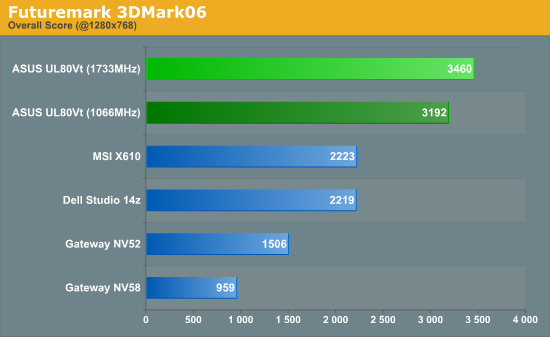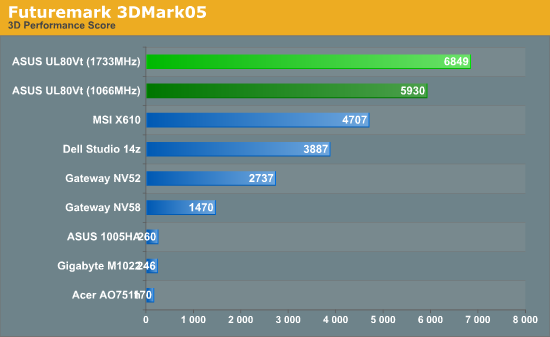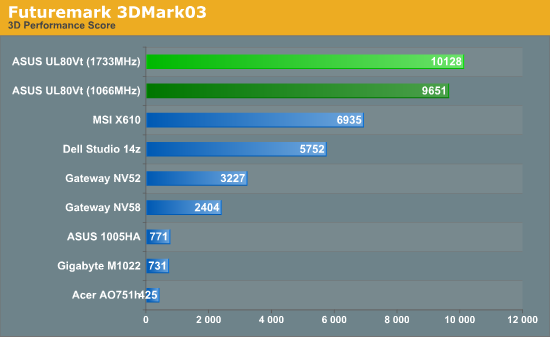ASUS UL80Vt First Look: Mobility Redefined
by Jarred Walton on October 24, 2009 8:00 PM EST- Posted in
- Laptops
ASUS UL80Vt Benchmarked - Graphics Performance
Our testing for now is confined to the use of the discrete GeForce G210M graphics on the UL80Vt. When we deliver our full review, we will include additional results using the integrated GMA 4500MHD. You can get a good idea of the 4500 MHD performance by looking at the Gateway NV58 results; the NV58 has a faster CPU, but for 3DMark and gaming performance the GPU is going to be a huge bottleneck.




Looking at 3DMark graphics performance, the G210M combined with the overclocked SU7300 delivers respectable performance. The G210M is clearly faster than the 9400M G integrated solution, with the advantage ranging from a low of 30% in 3DMark Vantage up to a high of 76% in 3DMark03. We realize 3DMark isn't true gaming performance, but most games correlate well with one of the versions. 3DMark06 and Vantage include CPU performance into the final score, which is why the gap between the 14z and UL80Vt isn't quite as large -- the P8600 should be at least 39% faster than the overclocked SU7300, and the detailed results confirm that. The CPU score in 3DMark06 is 1571 for the UL80 compared to 2117 with the 14z (a 35% advantage to the 14z), while the CPU score in Vantage is 3344 vs. 4284 for the 14z (28% faster). Meanwhile the 3D scores favor the UL80 by 58% in Vantage and 69% in 3DMark06. For reference, the Gateway NV52 with HD 3200 isn't even close in 3DMark; the UL80Vt is 130% to 214% faster!
Even at 1066MHz, the SU7300 with the G210M puts up a fight. The lead drops to 7.5% in Vantage (due primarily to the low CPU score), but it's still 44% in 06, 53% in 05, and 68% in 03. The comparison to the NV52 continues to be a landslide in favor of the SU7300+G210M: it's 105% faster in Vantage and up to 200% faster in 3DMark03.
We recognize that 3DMark isn't the be-all, end-all indicator of gaming performance, but as a quick test we can see that UL80Vt with the G210M enabled should never be slower than laptops with integrated graphics when it comes to gaming (i.e. the Dell 14z with 9400M G and the Gateway NV52 with HD 3200). It's also worth noting that the UL80Vt supports NVIDIA's reference drivers, just like other laptops with GeForce graphics (although you'll need to wait for updated drivers from NVIDIA if you want something newer than the 186.88 drivers the laptop ships with). At present, for graphics in notebooks the pecking order is roughly as follows:
- High-end and midrange discrete solutions (GeForce GTX 280M/260M and Mobility Radeon HD 4670 and 4870)
- Lower end discrete solution (Radeon HD 4330 and HD 3670, or GeForce 210M and 9600M, etc.)
- NVIDIA's current integrated graphics (GeForce 9400M G -- represented by the Dell Studio 14z).
- ATI's current integrated graphics (Radeon HD 3200 -- i.e. the Gateway NV52).
- Intel GMA 4500MHD and older NVIDIA/ATI IGP solutions (X1260 or GeForce 7000 or earlier).
- Intel's GMA 950 and earlier (typically seen in netbooks now).
The corollary to the above is pricing and power, and generally speaking the higher you go on the list, the more expensive the parts become and the worse battery life you get. That's the great benefit of designs like the UL80Vt: you can get reasonable graphics performance when you need/want it, but you can still switch off the graphics and run on the IGP for improved battery life. The G210M is designed to use a maximum of 8W, but when the rest of the laptop averages less than 10W of power, that's a potential 80% increase in power requirements. The slower IGP solutions -- especially from Intel -- do manage to keep power requirements low while offering dismal gaming performance. The HD 3200 and 9400M are much more palatable in terms of overall performance and video offloading features, with power requirements that are about the same as the GMA 4500.










100 Comments
View All Comments
7Enigma - Monday, October 26, 2009 - link
I'll do it for you. Using an old review from April09 where they posted the min/WHr:MacBook2008 got a 6.36
Asus gets a 6.32 (531min / 84 WHr)
It is important however to note if the testing methodology (ie websites used/etc.) have changed significantly since the 2008 Macbook review and if so in which direction (my guess would be more draining now).
If they are directly (or closely) comparible then you have to factor in weight difference and price, and of course CPU/GPU performance differences. Since the price is $150 cheaper, the weight difference IMO would have to be significantly lighter for the MacBook to justify (build-quality, OS, intangibles aside).
JarredWalton - Monday, October 26, 2009 - link
All I know for certain is that the old results had Apple at 6.36 (as mentioned), but the tests are not the same as the ones I used for the Windows laptops. Anand has the new Internet tests I'm using (I ran them on Linux, so they should run fine on OS X), so when he's had a chance to run numbers we can make the comparison. The UL80Vt is twice the relative battery life of most Windows laptops, and over three times the relative battery life of higher-spec units. I can't say for certain whether it has matched or surpassed the latest MacBook, but it should be very close if not better.Pirks - Monday, October 26, 2009 - link
"32% in DivX encoding, and xxx% in CINEBENCH R10"xxx%? Really?! Are you hiding something from us Jarred? ;)))
JarredWalton - Monday, October 26, 2009 - link
LOL... sorry, I was still running tests at the time and obviously missed that. It's 12% BTW; text updated.mczak - Sunday, October 25, 2009 - link
I'm wondering why asus uses a overclocked ULV chip. Presumably they increase voltage a bit when overclocked to guarantee stable operation right? So in this case power should be very similar to LV chips (+30% for higher clock plus something additional for more voltage - ULV chips are 10W, LV 17W). So why not get a non-overclocked LV chip like the SL9600 in the first place? 2.133Ghz, 6MB cache, should cost about the same as the SU7300.JarredWalton - Sunday, October 25, 2009 - link
CPU-Z reports the voltage as 0.875V -- at the overclocked 1.73GHz setting. The ULV parts are essentially CPUs that work well with very low voltages, and they usually have better overclocking headroom. Anyway, it appears that even overclocked, the SU7300 isn't consuming more than perhaps 12-13W. (I'll have to do more testing to verify that figure for the full review.) When you have a laptop that uses 9.5W on average for Internet surfing, an extra 3W is a big deal.mczak - Monday, October 26, 2009 - link
Those 0.875V are presumably at idle? Would be way below published VID range under load (hopefully cpu-z reports this correctly even for mobile cpus).I just doubt a ULV chip is really any better if you overclock it to the level of a LV chip. Unless you're courageous and don't overvolt it to the same level, though you could just undervolt a LV chip instead...
In any case, I'd be very interested in the voltage adjustments (if any) under idle/load for OC/-nonOC setting - of course those chips have a VID range and hence could vary by chip but in practice they don't vary that much and the asus overclocking would presumably add a fixed voltage increase (if any).
mschira - Sunday, October 25, 2009 - link
Amazing, the most interesting new laptops at the moment are all cheap ones.Like the acer Timelines, the Asus"WTF have they been thinking with that name", the Dell Studio 14z etc.
They are all very nice, but they have compromises to keep em cheap. Not too bad compromises, but still.
Why doesn't Asus make a Lambougini version of this little nice buddy? Ditch the CD drive - who needs those - give us a nice screen, give us an expensive light, great case.
I'll happily pay the premium - it's not going to be that much anyway.
M.
KikassAssassin - Sunday, October 25, 2009 - link
Wow, with the exception of the screen, this thing is almost exactly what I've been looking for in a laptop. I've been really disappointed in the seeming non-existence of an affordable, highly-portable laptop with a dual-core ULV processor, non-Intel graphics, and a high-Wh battery. Put a high-quality display with a matte overlay (WhyTF is almost every laptop using freaking glossy nowadays?), and a toggle-able back-lit keyboard on this thing, and it would be my perfect laptop to a T.I also really like the idea of the ability to toggle between low-power integrated graphics and higher-performing discreet graphics, and I wish more laptops would include this feature. I have a feeling nVidia's going to be pushing hard for this once Arrandale comes out.
hybrid2d4x4 - Sunday, October 25, 2009 - link
One request for the game testing section: add an older title s/a Half-life 2 in addition to the usual new new games. I'm more interested in what it can run than the obvious "well, there you have it- it won't run the latest titles, get a desktop for that".Looking forward to the review!!